Time Capsules – Canadian Conservation Institute (CCI) Notes 1/6
(PDF Version, 1.37 MB)
CCI Note 1/6 is part of CCI Notes Series 1 (Care of Collections - General Guidelines)
Introduction
Containers filled many years ago with documents and other artifacts are occasionally recovered from the foundations of buildings. The material in these time capsules is often in fragile condition and must be extracted with great care. More frequently, time capsules containing current material are put in place during construction of new buildings. Few guidelines on this practice are available and much harm can come to enclosed material prepared improperly and buried under inadequate conditions. The following information is intended for people who have retrieved old time capsules or who are intending to bury new ones.
Old Time Capsules
Copper sheet and tinplate were the most commonly used materials of the 19th-century time capsule maker. They were most often formed into boxes or tubes and were sealed with a soft, lead / tin solder. In general, time capsules made this way survive in relatively sound condition. However, moisture trapped in the interior, together with caustic flux used in soldering, may cause significant corrosion of both the copper and the underlying steel in the tinplate. This results in a highly acidic environment, which causes discolouration and possible disintegration of the enclosed materials, especially if they are organic materials like paper, leather, and textile. Also, if different metals are kept in contact for long periods of time, small electric cells are set up in the presence of moisture and salts. Corrosion at the joins of containers is accelerated under these conditions. This can happen between the constituent metals of the solders and the materials that they join.
Occasionally, bottles have been used to enclose documents and other materials. A well-sealed bottle made of stable glass may survive very well, but there have been instances of glass containers being broken due to foundations shifting, frost creeping, or carelessness at the time of retrieval.
The material of which the container is made is not the only factor that may affect the contents. Once a time capsule is sealed, the micro-climate within will dictate the fate of its contents. Obviously, if water vapour and oxygen are trapped inside, they will interact with any susceptible materials and will cause degradation. While the container itself may not corrode, metal artifacts inside will be affected by the presence of water and oxygen. The by-products of their corrosion will affect other materials with which they are in contact. As mentioned above, organic materials like leather, paper, and cloth may be stained by corrosion products or may disintegrate altogether. Oxygen and water also have a direct effect on organic materials, causing chemical breakdown of their structures.
Some materials, particularly mass-produced paper, are acidic by nature, and sealing them into a closed environment will prevent escape of their volatile acidic emissions. Acidic vapours can therefore build up to levels far in excess of those normally encountered in an open environment. Degradation is greatly accelerated under these conditions.
Although they are not encountered very often in 19th-century time capsules, relatively modern materials like rubbers and plastics have been found to liberate acidic vapours. Similarly, paints, varnishes, and other coatings on artifacts can contain synthetic materials that are prone to degradation. The volatile by-products accumulate within the enclosed space with a resulting increase in the rate of deterioration.
Micro-organisms and fungus can also be sealed into a container and, under the right conditions, can cause accelerated decay of organic materials. Insects that feed on organic material (book lice, for example) could be hidden in folds of paper or textile. Mould spores, normally present on many materials, need only the right environment to proliferate. All these biological agents will remain viable as long as the supply of oxygen lasts.
Opening Time Capsules
Opening time capsules gives practical information on the relative merits of containers and the durability of contents. It can tell us a great deal about the right way to prolong, as much as possible, the survival of the material within. The problems encountered when attempting to open old containers indicate that the foresightedness of our ancestors was concentrated primarily upon the contents.
A time capsule that has been carefully retrieved from a site should be handled with care; contents that have lain undisturbed for decades may be in very fragile condition. Avoid the very common practice of shaking the container, and keep the orientation of the capsule as it was when found. This way, fragile contents will not be disturbed, and any leaked water will not wet previously dry materials. Examine the outside of metal capsules very carefully for possible leaks in the seams or closures. Check for inscriptions, which may include instructions for opening. There is no simple way of determining the exact nature of the contents of metal boxes without opening them; x-rays that are powerful enough to penetrate the metal will show no shadow of less dense contents, except perhaps solid metal objects like coins.
Opening a sealed metal box entails a certain amount of destruction. Naturally, the cutting should be done as carefully as possible because the box itself is a historical artifact, but one should not be too concerned about causing damage; the container was made to be opened. If a time capsule in a glass bottle has to be opened, cutting or breaking the glass will obviously be a last resort, especially as old glass bottles can be very valuable. There is nothing to be gained by hurrying the opening. Material that has lain buried for decades can afford to wait a few hours more.
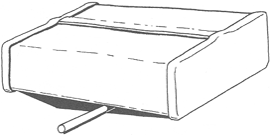
In order to get an idea of the distribution of the contents within the container, rest it on a 1/4" (6.3 mm) dowel and determine its point of balance. Assuming that the contents are distributed evenly, this may give an indication of which end is empty. Obviously, the presence of heavy artifacts like coins, or perhaps leaked water, at one end could be deceiving.
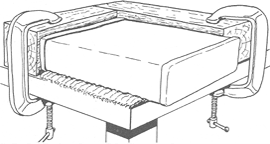
Open the time capsule on a stable bench or table covered with a sheet of polyethylene. Do not attempt to reverse solder joins by heating; it takes much less heat to make a solder join than it does to open one, so damage to the contents of the capsule could result very easily. Place the capsule on a pad of foam plastic, towelling, or other soft resilient material so that it overhangs the edge of the bench slightly. Wood blocks on two sides will be sufficient to prevent the time capsule from moving during opening (Figure 2).
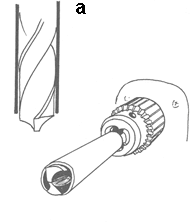
Before beginning with cutting tools, first drill a pilot hole near one corner of the container. Surround a 3/8" (9.5 mm) diameter drill bit nearly to the tip with a piece of 3/8" (9.5 mm) bore metal tubing (Figure 3a). This provides a stop for the drill to prevent its breaking through too far into the container.

If drill grinding equipment is available, the cutting angle of the drill can be adjusted from the usual 60° to 30°, further limiting penetration (Figure 3b). Use a variable speed power drill to drive the bit. Once the hole has been made, the interior of the capsule can be inspected and the line of the cut can be plotted. If possible, insert a fibre optic viewer through the hole to get an idea of the disposition of the contents.
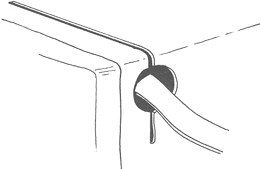
Use a junior hacksaw with a fine-toothed blade to cut open the capsule. This takes longer than using a large hacksaw but allows for much better control. Stop cutting frequently to assess progress and to check that none of the material in the interior is being touched by the saw. It is often possible to insert a thin ribbon of plastic through the drill hole to protect documents or other fragile materials that lie close to the saw cut (Figure 4). Square boxes only need to be cut on three sides; bend back the fourth side to expose the contents. Circular containers, on the other hand, must be cut almost all the way around. Before removing the contents, turn back the edge of the cut with pliers to avoid snagging on the contents as they are extracted.
Once the contents are exposed, they can be carefully removed and spread out on clean blotting paper. Separate artifacts from each other, but do not attempt initially to unroll, unwrap, or unfold papers. Paper and textile artifacts can be extremely fragile after prolonged aging. Take special care not to stress the folds until their exact condition can be assessed. All material removed from the time capsule must be allowed to equilibrate to the ambient relative humidity for several hours at least.
Unless the contents are judged to be in excellent condition, it is advisable to contact a conservator for advice on care, handling, and treatment.
Constructing a Time Capsule
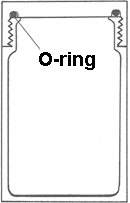
By far the best modern material for burial is stainless steal. It is relatively inexpensive and easily fabricated, and its stability in adverse conditions is excellent. A container with a threaded end cap and an O-ring seal will be easy to open (Figure 5); however, such a container is extremely expensive to make and the materials in the O-ring might degrade over a long period of time.
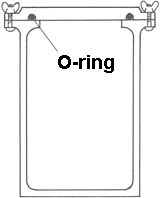
As a less expensive alternative, use wing nuts to clamp the lid in place (Figure 6). Both of these designs have the disadvantage that screw threads can become "seized" when left in contact and under pressure for long periods, thus making them difficult to unscrew.

Another less expensive option is to make the box of sheet metal and to weld it shut once it has been filled (Figure 7). This will be more difficult to open but has the advantage of excellent sealing, provided that the welding is done well.
It is tempting to consider sealable plastic containers for making time capsules, but too little is known of the long-term stability of most plastics under burial conditions to warrant the risk. The chances of the plastic cracking under cold conditions are very high, and the seals would be suspect over a period of many years. Nevertheless, it is possible to construct a "box-within-a-box" by encasing a sealed plastic container in a thick layer of paraffin wax. Lay the time capsule on a bed of wax 1" (2.5 cm) thick in the bottom of a larger container, and pour melted wax all around and over the top to a thickness of 1" (2.5 cm). On the other hand, sealable polyethylene containers are quite adequate on their own for time capsules intended for indoor use.
The Contents
A brief survey of the contents of time capsules opened by CCI staff over a period of some years reveals a not-altogether-surprising lack of imagination. In many cases, the capsules contain documents of purely parochial interest, albeit of a timely nature. These may include such items as newspapers of the day, parish registers, and even annual church accounts. Documents of this kind found in time capsules less than 100 years old may well be duplicated in local archives, often in better condition than those enclosed in a capsule. For example, in 90% of cases, a newspaper of the week or day of burial is included in the capsule despite the fact that many newspaper publishers have supported, and continue to support, substantial archives of their publications. Similarly, circulated coins of marginal numismatic value are often included. While these may provide a "touchstone" to the past, they provide very little else, and certainly nothing of specific historical value. Even though it is rare for the contents of a time capsule to contain anything of more than local value or interest, there are occasional dramatic exceptions.
With this in mind, it should be the prime responsibility of the buriers to choose materials intelligently and to ensure that the artifacts so chosen are appropriate and evocative of our times. For example, consider including manufactured products of some complexity; artifacts which, if they survive into the next century at all, will not normally do so in unused condition, i.e., electronic calculators, small power tools, wrist watches, etc. Another aspect of our throw-away society is packaging material, some of which is very skillfully designed and says much about our attitudes. If coins are to be included, ensure that they have never been circulated or handled. A little imagination will provide material of this kind that also has a local interest.
If possible, avoid paper documents, particularly photographs unless they are of archival quality, due to their known instability. If paper is included, separate items from each other by enclosing them in sealed Mylar sleeves. A better alternative to paper documents and photographs is archival-standard microfiche. This is a great deal more stable and, of course, much more economical of space. Avoid including magnetically recorded material like audio or video tapes; unless these are re-wound periodically, their quality can deteriorate very badly. Also, it is not certain that such recordings will be playable in the future, unless the retrievers have access to working museum pieces! Compact discs can be included if a player is also part of the inventory.
Conditioning the Interior
If the contents of the sealed container are to be preserved, it is necessary to exclude oxygen and water as much as possible. (Light must also be excluded, but this is not, of course, a consideration.) However, it has been shown that a complete absence of oxygen can cause certain mineral oxide pigments to fade. Also, it has been reported that if materials such as paper and textile are completely dried, they become brittle and can be severely damaged by careless handling on retrieval. If a dry environment can be achieved in the container, a warning on the fragility of the contents could be included along with instructions for reconditioning them to ambient relative humidity. For the ideal interior environment, therefore, aim for a dry and relatively oxygen-free atmosphere. Several methods for doing this are outlined below.
Passive Protection
If the capsule is sealed when the relative humidity is very low and the air is cold, it is possible that the contents will be minimally damaged during burial. This depends largely upon what the contents are, the average temperature of the place where they will lie, how much moisture they contain, whether they have corrosive components, and whether they have a guaranteed long-term stability. In other words, passive methods of protecting the contents (which one normally encounters in early time capsules) are unreliable at best.
Drying
Drying is the single most important factor for the preservation of materials. One of the most effective substances for absorbing water is silica gel, which is used for conditioning the interiors of packing cases, scientific instruments, etc. In order to make the interior of a time capsule as dry as possible, at least one-fifth of its volume should be packed with dried silica gel crystals, i.e., with silica gel that has been heated at 150°C in an oven overnight to drive off all moisture. Indicating silica gel contains a dye that will turn deep blue once it is dry. Spread the silica gel on a metal tray to a depth of not more than 0.4" (1 cm) during drying. Insert it into the time capsule after the contents have been added and just prior to closing. The silica gel must be isolated from the artifacts by placing it in a linen or cotton bag. As an alternative to silica gel, a thick, multi-layered sandwich of good-quality acid-free blotting paper may be used. The paper should be dried in an oven in the same way as the silica gel before being inserted.
Removing Oxygen
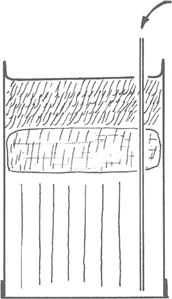
Even with all water removed from the interior of the container, degradation of the contents of a time capsule can still take place due to the presence of oxygen. Oxygen can be removed by both passive and active methods. The capsule can be flushed with dry nitrogen just prior to closing in order to displace most of the oxygen contained in the air. Attach the lid of the container and leave a small hole in which a hose may be loosely inserted. The hose should reach the bottom of the container (Figure 8). Flush dry nitrogen from a tank through the capsule for at least 15 minutes, and then seal the hole quickly. This process is never 100% efficient; some residual oxygen will remain, which can be advantageous if sensitive pigments are present.
Active removal of oxygen will occur when the oxidative degradation of organic materials and the respiration of micro-organisms and fungus take place. Thus, if the container is perfectly sealed, the oxygen will be depleted to the point where the reactions cease. Because oxygen constitutes 20% of the volume of the atmosphere, removing the oxygen in a sealed container will result in a negative pressure. Any slight leak in the capsule will allow air, water, and debris to be drawn into the interior. Perfect sealing and a strong container are critical in this case.
Preparing the Contents
Each artifact chosen for inclusion in the time capsule should be enclosed in a polyethylene or Mylar bag, or in a box to ensure that dissimilar materials are isolated from one another. For most stable materials, it is better not to seal bags or boxes because the objets only need to be isolated from each other, not from the environment of the capsule. (Paper, and any other objects suspected of instability, are exceptions.) Sealable plastic containers are very useful for isolating materials from each other.
If paper documents are included, do not fold them sharply because this stresses the paper and can cause fractures at the crease lines. Folds can be padded with a stable polyethylene foam or with acid-free tissue paper. Documents should be clean and free from any form of contamination. Bulky paper works should be pre-dried for a few days in a closed container with dry silica gel prior to their inclusion in the capsule. (As mentioned previously, microfiche is a sensible alternative.)
Metal objects should be free of visible corrosion and in sound physical condition. Avoid polishing them before insertion unless removal of polish residues can be completely assured. Resist the temptation to apply protective coatings; there is no clear understanding of their long-term effectiveness, especially in such closed environments. De-grease metals with acetone to remove finger marks, which can cause etching and corrosion, and make sure thereafter to handle the objects with clean cotton gloves.
If an electronic device is chosen for inclusion, remove and discard batteries. In their place, include a note stating the voltage and current requirements of the device. Solar-powered instruments are an attractive alternative. Individual components can be wrapped in acid-free tissue paper before being put in polyethylene bags. Also, package boxes and instruction manuals separately.
Sealing
With the methods of construction shown in Figures 5 and 6, it is simply necessary to screw the lid firmly onto the container, thus squeezing the O-ring and effecting an excellent seal. As an added precaution, the ring and its seating can be coated with a silicone grease (e.g., Dow Corning High Vacuum Grease) or the whole container can be set in melted wax.
The welded box construction shown in Figure 7 requires more time and care to seal completely but has a far superior seal. As can be seen in the diagram, the lip to be welded is as far from the contents as possible and is isolated from them by a layer of glass fibre insulation. To avoid over-heating the metal, use an electric arc, not a gas flame, for the welding. Check very carefully that the weld is intact around the entire circumference of the lip.
If a welded box has been used, it is important to mark the end that should be opened. The metal container can be indelibly marked on the outside with a punch before it is filled. Similarly, a warning may be placed on the box concerning the fragility of the contents.
Enclosing or Burying
It is not uncommon to find old time capsules buried below ground level in the foundations of buildings. If the capsule is completely sealed and has been prepared as suggested above, this generally results in no damage to the contents. In fact, the container may be better insulated below ground level than above. However, in less-than-ideal interments, fluctuating temperature and ground water levels on the outside may influence the interior, especially if significant amounts of water remain inside the capsule. Condensation of atmospheric moisture in the interior is a possibility under these circumstances. Also, if stainless steel has not been used, corrosion of the capsule will result. It is therefore best to enclose the time capsule in a wall above the frost and ground water level.
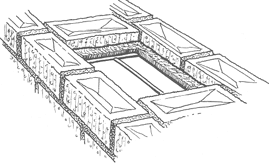
Build a drained concrete or brick vault lined with fibreglass insulation to minimize temperature fluctuations and to prevent water from getting in (Figure 9). If stainless steel has not been used for the container, seal the container tightly in a polyethylene bag or enclose it in a block of wax before cementing it in place. When the capsule is cemented or bricked in, avoid resting any weight on it. Over a long period of time, the seams of the box could become strained and begin to leak. The site of the time capsule is often marked on the outside wall with a plaque or carved inscription.
Conclusion
CCI staff have responded to many enquiries about construction and preparation of time capsules. These enquiries have had one thing in common: that the time capsule must be ready for burial in an unrealistically short period of time. The planners rarely leave enough time to do the job well. If a time capsule is to be buried properly the correct materials must be used, the artifacts must be selected and prepared with care, and the container must be made to withstand its journey through time. It is a waste of effort to prepare a time capsule in a hurry. There is nothing quite so sad as a time capsule whose contents have deteriorated so badly as to be useless.
There is absolutely no evidence to suggest that people 100 years hence will have the slightest interest in time capsules. In fact, considering the number of things piling up in museums, the manyfold increase in historical studies and books, and even the proliferation of antique, junk, and collectible stores, it is more probable that people of the future will so inundated with historical material that a time capsule may be less exciting to them than we anticipate. Think about this and try to make the contents worthy of the effort and evocative of the times we live in. Finally, if none of the above advice is taken, at least ensure that a microfiche copy of this publication is included so that our well-meaning intentions will be properly construed.
Recommended Reading
-
Australian Institute for the Conservation of Cultural Material (Inc.), The Preparation of Time Capsules. Information Sheet Nº 3, Canberra: AICCM, .
-
Durrans, B. "Posterity and Paradox: Some Uses of Time Capsules," in Sandra Wallman (ed.), Contemporary Futures: Perspectives from Social Anthropology (Association of Social Anthropologists Monographs, 30), London and New York: Routledge, .
-
Field, B.P. "U.S. History in a Box," National Geographic, vol. 175, nº 5 (), pp. 652-660.
-
Fraser, Helen. The Time Capsule: Repository of the Past or Romantic Notion? AASLH Technical Leaflet #182. Nashville: American Association for State and Local History, .
-
Jarvis, W.E. "Time Capsules," Encyclopedia of Library and Information Science, New York: Marcel and Dekker, , vol. 43, supp. 8, pp. 331-355.
-
Logan, J.A. and G.S. Young. "A Message in a Bottle: The Conservation of a Waterlogged Parchment Document," Journal of the International Institute for Conservation — Canadian Group, vol. 12 (), pp. 28-36.
Copies are also available in French.
Texte également publié en version française.
© Government of Canada,
Cat. Nº NM95-57/1-6-1995E
ISSN 0714-6221